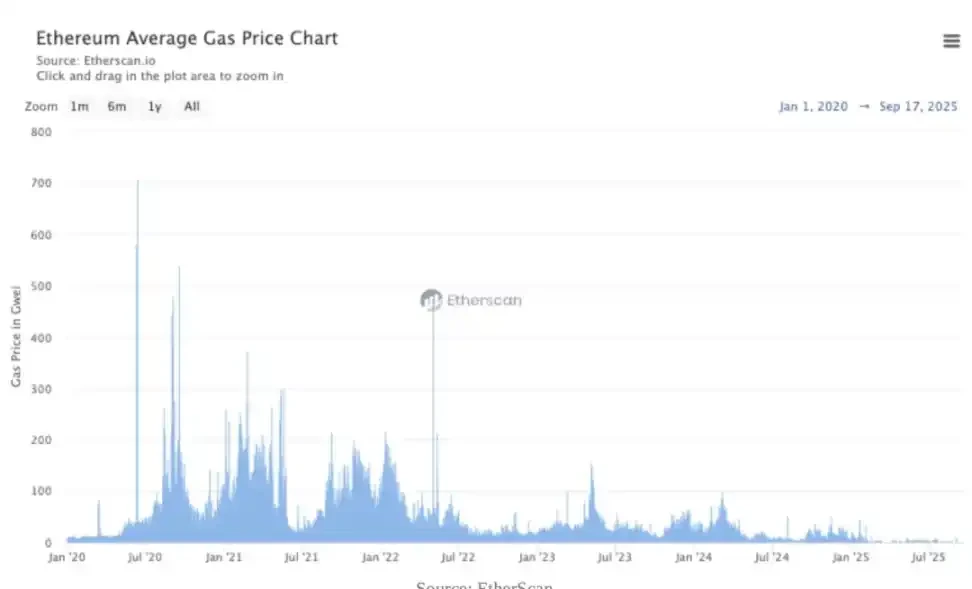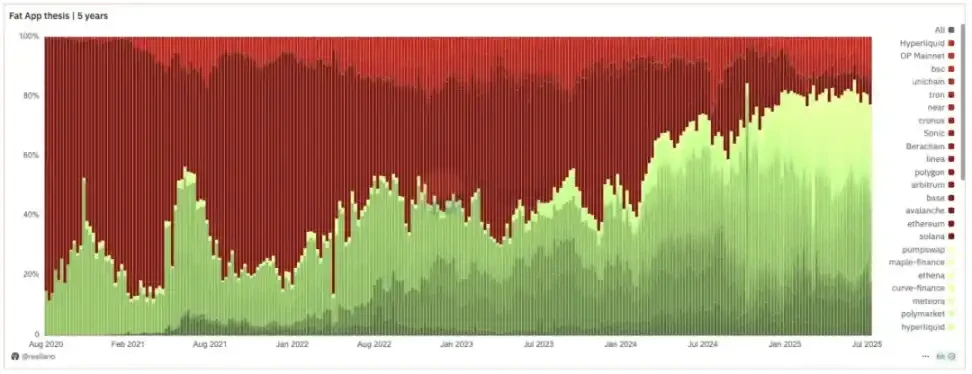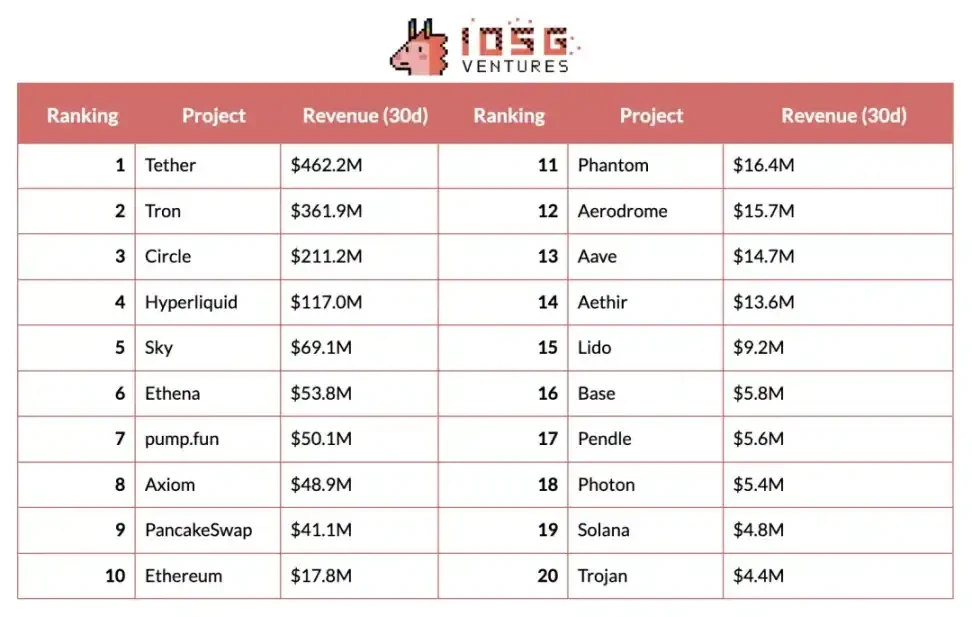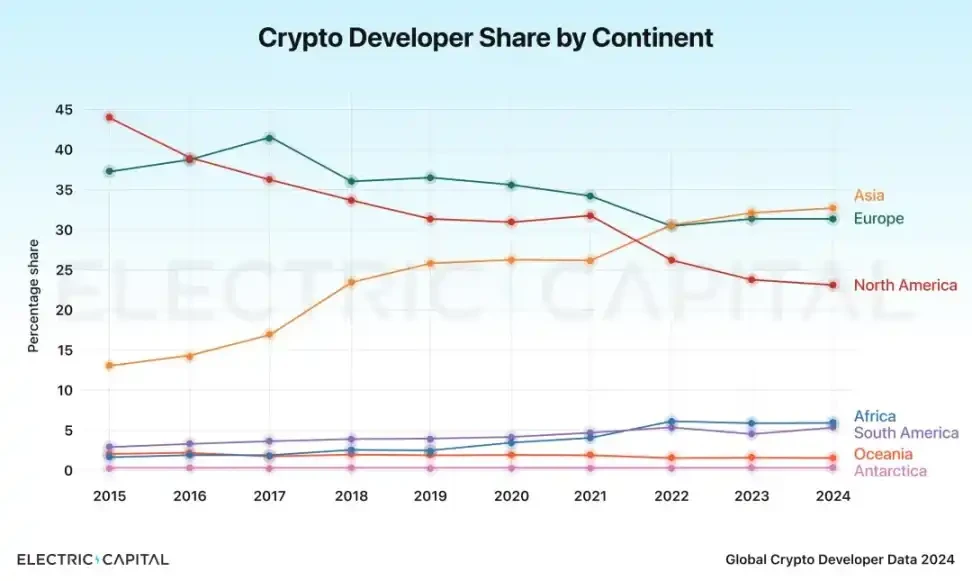Application Layer Bonus Explosion: A Golden Age for Asian Developers
Original author: Jiawei, IOSG Ventures
In the mid-to-late 1990s, internet investment focused primarily on infrastructure. The capital markets at the time were almost entirely betting on fiber optic networks, ISPs, CDNs, and server and router manufacturers. Cisco's stock price soared, reaching a market capitalization of over $500 billion by 2000, making it one of the world's most valuable companies; fiber optic equipment manufacturers such as Nortel and Lucent also became highly sought after, attracting tens of billions of dollars in funding.
In this frenzy, the United States added millions of kilometers of fiber optic cable between 1996 and 2001, far exceeding the actual demand at the time. As a result, a severe overcapacity emerged around 2000—transcontinental bandwidth prices plummeted by more than 90% in just a few years, and the marginal cost of connecting to the Internet approached zero.
While this infrastructure boom allowed later-born companies like Google and Facebook to take root and flourish on the cheap, ubiquitous internet, it also brought growing pains for the then-frenzied investors: the infrastructure valuation bubble burst rapidly, and the market value of star companies like Cisco shrank by more than 70% in a few years.
Doesn't this sound a lot like Crypto from the past two years?
Is the era of infrastructure coming to a temporary end?
Block space has gone from scarce to abundant.
The expansion of the block space and the exploration of the "impossible three" of blockchain largely dominated the early development of the crypto industry for several years, and therefore it is appropriate to discuss it as a landmark element.

▲Source: EtherScan
In conclusion, key Ethereum upgrades (such as EIP-4844) migrated L2 data availability from expensive calldata to lower-cost blobs, significantly reducing the unit cost of L2. Transaction fees for mainstream L2 blockchains have generally decreased by several US dollars. The introduction of modularity and Rollup-as-a-Service solutions has also significantly reduced the marginal cost of block space. Various Alt-L1 blockchains supporting different virtual machines have also emerged. As a result, block space has transformed from a single, scarce asset into a highly fungible commodity.
The chart above shows the evolution of various L2 on-chain costs over the past few years. It can be seen that in 2023 and early 2024, calldata accounted for the majority of costs, with daily costs even approaching $4 million. Then, in mid-2024, the introduction of EIP-4844 allowed Blobs to gradually replace calldata as the dominant cost, significantly reducing overall on-chain costs. After 2025, overall costs have tended to be at a lower level.
In this way, more and more applications can place their core logic directly on the blockchain, instead of adopting a complex architecture that processes off-chain data and then uploads it to the blockchain.
From this point on, we see value capture begin to migrate from the underlying infrastructure to the application and distribution layer, which can directly handle traffic, improve conversion rates, and form a closed loop of current flow.
Evolution of income
Following on from the discussion in the last paragraph of the previous chapter, we can intuitively verify this viewpoint at the revenue level. In a cycle dominated by infrastructure narratives, the market's valuation of L1/L2 protocols is mainly based on expectations of their technological strength, ecosystem potential, and network effects, i.e., the so-called "protocol premium."
Token value capture models are often indirect (e.g., through network staking, governance rights, and vague expectations of renewal fees).
Application value capture is more direct: verifiable on-chain revenue is generated through renewal fees, subscription fees, and service fees. This revenue can be directly used for token buybacks and burns, dividends, or reinvested in growth, forming a tight feedback loop. The application's revenue streams become more robust—coming more from actual service fee revenue than from token incentives or market narratives.

▲Source: Dune@reallario
The chart above roughly compares the returns of Protocol (red) and Applications (green) from 2020 to the present. We can see that the value captured by Applications is gradually increasing and has reached approximately 80% of the total this year.
The table below lists the 30-day protocol revenue rankings compiled by TokenTerminal. L1/L2 only account for 20% of the 20 projects. Stablecoins, DeFi, wallets, and trading tools are particularly prominent applications.


▲Source: ASXN
Furthermore, due to the market reaction to buybacks, the correlation between the price performance of application tokens and their earnings data is gradually increasing.
Hyperliquid's daily buybacks of approximately $4 million have provided significant support for the token price. Buybacks are considered a key factor driving the price rebound. This indicates that the market is beginning to directly link protocol gains and buyback activity to token value, rather than relying solely on sentiment or narrative. And I expect this trend to continue to strengthen.
II. Embracing the New Cycle with Applications as the Main Theme
The Golden Age of Asian Developers

▲Source: Electric Capital

▲Source: Electric Capital
According to Electric Capital's 2024 Developer Report, blockchain developers in Asia accounted for 32% of the total, surpassing North America to become the world's largest developer hub.
Over the past decade, global products such as TikTok, Temu, and DeepSeek have demonstrated the outstanding capabilities of Chinese teams in engineering, product development, growth, and operations. Asian teams, especially Chinese teams, possess a strong iterative pace, can quickly validate needs, and achieve overseas expansion through localization and growth strategies. Crypto perfectly aligns with these characteristics: it requires rapid iteration and adjustments to adapt to market trends; and it needs to simultaneously serve global users, cross-language communities, and multi-market regulations.
Therefore, Asian developers, especially Chinese teams, have a structural advantage in the Crypto application lifecycle: they possess both strong engineering capabilities and a keen sensitivity to market speculation cycles, along with exceptional execution ability.
Against this backdrop, Asian developers have a natural advantage, enabling them to deliver globally competitive crypto applications more quickly. Projects like Rabby Wallet, gmgn.ai, and Pendle, which we've seen in this cycle, represent Asian teams on the global stage.
We anticipate seeing this shift soon: a new market trend moving away from a US-dominated narrative towards a model where Asian products are first launched, then expanded into European and American markets from there. Asian teams and markets will have more say in the application cycle.
Primary market investment under the application cycle
Here are some perspectives on primary market investing:
Trading, asset issuance, and financial applications still offer the best product-to-market (PMF) ratios, and are practically the only products capable of weathering a bear market. These correspond to products like Hyperliquid (perp), Pump.fun (launchpad), and Ethena, respectively. The latter packages capital rate arbitrage into a product that can be understood and used by a wider range of users.
If there is significant uncertainty in investing in a specific niche market, consider investing in the beta of that sector and figuring out which projects will benefit from its growth. A typical example is prediction markets—there are approximately 97 publicly available prediction market projects, with Polymarket and Kalshi being the clear winners. In this case, the probability of betting on a mid-to-long-term project to overtake the leader is very low. However, investing in tool-based prediction market projects, such as aggregators and chip analysis tools, offers greater certainty and the potential to reap the benefits of the sector's growth, transforming a difficult multiple-choice question into a single-choice one.
Once the product is developed, the next key step is to truly bring these applications to the masses. Besides common entry points like Social Login provided by Privy, I believe that a unified trading front-end and mobile platform are also crucial. Throughout the application lifecycle, whether it's perp or prediction markets, mobile will be the most natural user interface. Whether it's the user's first deposit or frequent daily operations, the experience will be much smoother on mobile.
The value of an aggregation front-end lies in traffic distribution. Distribution channels directly determine user conversion efficiency and project cash flow.
Wallets are also an important part of this logic.
The author believes that wallets are no longer simply asset management tools, but rather have a role similar to Web2 browsers. Wallets directly capture order flows, distributing them to block builders and searchers, thereby monetizing traffic. Simultaneously, wallets also act as distribution channels, connecting to third-party services such as staking through built-in cross-chain bridges and DEXs, becoming a direct entry point for users to access other applications. In this sense, wallets control order flows and traffic distribution, serving as the primary entry point for user relationships.
Regarding the infrastructure throughout the entire cycle, I believe that some public chains created out of thin air have lost their meaning; however, the infrastructure that provides basic services around applications can still capture value. Several specific examples are listed below:
- Provides infrastructure for customized multi-chain deployment and application chain building for applications, such as VOID;
- Companies that provide user onboarding services (covering login, wallet, deposits and withdrawals, cash withdrawals, etc.), such as Privy and Fun.xyz; this can also cover wallets and payment layers (fiat-on/off ramps, SDKs, MPC hosting, etc.).
- Cross-chain bridges: As the multi-chain world becomes a reality, the surge in application traffic will urgently require secure and compliant cross-chain bridges.
[Disclaimer] Investing in the market involves risks, and caution is advised. This article does not constitute investment advice, and users should consider whether any opinions, views, or conclusions in this article are suitable for their specific circumstances. Any investment decisions made based on this information are at your own risk.
- 核心观点:区块链投资重心正从基础设施转向应用层。
- 关键要素:
- 以太坊升级使L2成本下降超90%。
- 应用收入占比达80%,超越协议层。
- 亚洲开发者占比32%,成最大开发力量。
- 市场影响:推动应用创新与亚洲市场崛起。
- 时效性标注:中期影响



